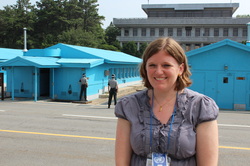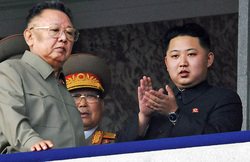
With the clock counting down I've still been slowly ticking off items on my "bucket list". Pretty high on that list was a visit to the DMZ. The demilitarized zone (DMZ) is the border between North and South Korea. It is supposed to be the most heavily armed border in the world - which isn't surprising when one realizes that technically the two countries are still at war.
The DMZ is divided into different sections - the Joint Security Area (JSA), the 3rd tunnel, an outlook post and Dorasan Train Station. There are a few tour groups which visit the DMZ visiting the various areas within the DMZ however the USO tour is supposed to be the best mainly because it includes a visit to the JSA (as do one or two others).
Reuniting the Peninsula - The 3rd Tunnel of the DMZ
Naturally since the USO (Koridoor) tour is one of the best it is also one of the busiest and fills up quickly even though tickets are nearly $100 USD per person. I was fortunate to secure a spot in June and after submitting the necessary information I had a ticket. So one evening after school I traveled up to Seoul so I could visit the DMZ early the next day.
Our trip started at the USO headquarters next to Camp Kim, the U.S. military base located in Seoul. Participants must follow a strict dress protocol - t-shirts must be collared, no shorts or gaucho pants (capris?) in addition to no open-toed shoes. The enforcement of these rules varied - I saw women wearing non-collared t-shirts as well as a guy wearing shorts but I also witnessed a woman being refused on the trip because she was wearing sandals.
The guide for the trip was Brandon, the manager of the USO. We were fortunate enough to have Brandon as a guide in part because of his background - a Korean who was born and raised on the peninsula he moved to the United States at 20 and enlisted in the U.S. army in which he served for 10 years. His service enabled him to obtain U.S. citizenship and therefore disallowed him from serving in the Korean army. Being Korean he could explain aspects of Korean culture as well as share his insight on how Koreans feel about the North/South situation (most aren't for it due to North Korea's economic state). As a former U.S. soldier he could also offer some perspective on the U.S. military involvement on the peninsula.
Truce Village - Joint Security Area
| Our first stop on the tour was Camp Bonifas where we received a 15 minute presentation that outlined the history of the conflict on the peninsula. A portion of that presentation is in the clip on the left. The volume of the soldier's voice is a bit low due to my distance from him. However, one can still follow the visuals in his presentation which illustrate the shift in territory during the war.
| |
After the presentation we were loaded up on a bus and taken to Truce Village within the JSA. This is where North and South Korea meet and is under control of the United Nations Committee and North Korea. If you look at the picture above you can see a small raised area between the blue building - this is the actual border between the two countries. Before being permitted into this area we were given strict instructions by our US military escort such as not pointing in the direction of North Korea. We were permitted to stand at the top of the concrete stairs looking towards North Korea for 3 minutes before being herded into one of the blue buildings for 3 minutes. While we were visiting Truce Village South Korean soldiers stood guard and North Korean soldiers came out of their own building to watch us with binoculars.
South Korean and North Korean Soldiers in the Joint Security Area
| | Inside the blue building we were permitted to take photos near the South Korean soldiers but were requested not to stand too close to them. The two soldiers in the room were standing at the first stance of Tae Kwon Do and literally did not move the entire time we were in there (approximately 3 minutes). I asked our escort what criteria the South Korean military used for selecting these soldiers at the JSA and he responded that the only requirement with which he is familiar is that they must all stand over 6 foot. I certainly hope there's more to it than that - he said that they (the U.S. soldiers) are chosen based on having clean military and civilian records and receiving high marks within a number of tests in the military.
This building is positioned within both countries and therefore the photo of me on the left is of me standing in North Korea.
|
After we left Truce Village we stopped at a look out point where you can see into North Korea, specifically Propaganda Village - a "town" consisting of empty hollow buildings and world's third tallest flag pole hoisted on which is a flag so massive that it weighs nearly 600 pounds. The soldiers pointed out that they realized the village was in effectively empty years ago because lights inside of the taller buildings would shine bright and fade in higher floors indicating that it was a single light on the ground floor illuminating the entire building.
U.S. Soldier Escorts on the JSA Tour
After leaving the JSA and Camp Bonifas (where we left behind our military escort) the rest of the tour consisted of a visit at the 3rd tunnel - one of many tunnels dug by North Korea found within South Korea. It is suspected that there are tunnels as far into the country as Seoul. We then visited a lookout point which you could see into North Korea and finally Dorasan Train Station - where up until recently trains ran to Kaesong Industrial Complex, a factory run jointly by North and South Korea. The factory was closed during the spring when Kim Jong Eun threatened war against South Korea and the United States. At the moment the train station is just an empty building though a woman still sells tickets (visitors can go out to the platform with a ticket) and Korean soldiers stand guard.
Even at the DMZ things are "cutesy"
My visit to the DMZ (specifically the JSA) was probably one of the most interesting things I've seen or done in Korea. I was a bit surprised because I'm not a big war history buff but it was an interesting experience to see the actual border between two countries still technically at war and observe the precautions taken throughout the entire JSA.
Upon returning to Seoul and concluding the tour I set out for Itaewon, a neighborhood near Camp Kim which boasts a large selection of international restaurants and stores. As I walked there I came across a memorial park for the Korean Civil War. The park was filled with statues depicting the country being torn apart as well as military vehicles used during the war. Below are a few photos I took at the park - I think it was a fitting end to the day.

If you have opened a newspaper, turned on a TV or stepped outside your house at sometime since Monday you most likely have heard that Kim Jong Il, North Korea's 'Dear Leader' died. It would be remiss of me to have a blog and currently live in South Korea/the Republic of Korea without mentioning this newsworthy event. Kim has ruled North Korea (the Democratic People's Republic of Korea) for the past 17 years. If you are not familiar with the history of the country here is my limited understanding of it - the Korean peninsula, at one time an united country, was annexed by Japan in 1905 and divided into Soviet and American zones in 1945 following WWII. The Korean War in 1950 was fought by both sides trying to reclaim the other and has never officially ended. Kim Il-Sung lead the country from 1948 until his death in 1994 when his son, Kim Jong-Il took control of the communist country. Throughout the years he became well-known for his hardline communist policies, secrecy and support for North Korea's nuclear program which earned him a place on President Bush's infamous 'axis of evil' list.
I heard of Kim's passing through the internet and expected some type of reaction from my co-workers but instead it barely caused a murmur. The young female teacher who sits next to me leaned over to tell me of his passing and when I asked her how she felt she told me that she was anxious about his death. Kim's death creates a lot of uncertainty in a nation that is still technically at war with its neighbor and his heir to power, his youngest son Kim Jong-Un (pictured above with his father) is young, inexperienced and relatively unknown. Upon notification of his death South Korea's military went on high alert however, the United States' army has maintained the same level of alertness for it's military bases here in South Korea.
And for the moment that's where things stand. I will continue to follow the news about North Korea because I hope to visit it next year if things are stable. And to answer the questions you are now asking yourself - yes, American citizens can visit North Korea and yes, it is safe - you are accompanied at all times by not one but two guides during the entire trip. Though there are strong reasons against visiting the country including "supporting" a country that is renown for it's human rights abuses the argument can be made that this means the citizens are exposed to different people, thoughts and philosophies and one can hope that this could lead to a shift in perspective on outsiders and open up the country to more humanitarian aid which it desperately needs. My own reasons for visiting North Korea are less altruistic and more directed towards a personal interest in the ancestor veneration of former leaders, something I observed in Vietnam in regards to Ho Chi Minh and something I would like to see in North Korea in regards to Kim Il-Sung and now the recently departed Kim Jong-Il.